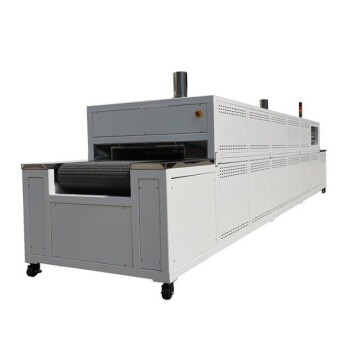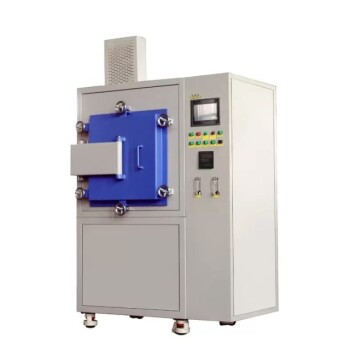In short, argon is a critical component in heat treatment for industries where material integrity is non-negotiable. It is most commonly used in aerospace, the production of high-performance alloys, and other advanced manufacturing sectors. These fields rely on argon to create a stable, non-reactive environment that protects sensitive and high-value materials during high-temperature processing.
The fundamental reason for using argon is its inert nature. By preventing oxidation and other unwanted chemical reactions at high temperatures, argon ensures that metals retain their specified mechanical strength, corrosion resistance, and structural integrity, which is essential for mission-critical applications.
The Critical Role of an Inert Atmosphere
Heat treatment involves exposing metals to extreme temperatures to alter their physical and sometimes chemical properties. However, this high-temperature environment also makes metals highly susceptible to reacting with gases in the atmosphere, particularly oxygen.
Preventing Oxidation and Discoloration
At high temperatures, most metals will rapidly oxidize when exposed to air. This oxidation can create a layer of scale on the surface, compromising the part's dimensions, finish, and performance. Argon displaces oxygen and other reactive gases, preventing this from occurring. This is particularly vital in processes like bright annealing, where a clean, scale-free surface is required.
Ensuring Material Purity
Beyond oxygen, materials can also react with nitrogen or trace elements in the air, leading to the formation of undesirable nitrides or other compounds within the metal's structure. These impurities can degrade the material's properties. An argon atmosphere acts as a protective shield, preventing any contamination and preserving the chemical purity of the alloy.
Providing a Controlled Cooling Environment
Argon is also used to manage the cooling phase of treatment. In processes like quenching, a controlled atmosphere is necessary to achieve a specific cooling rate without introducing thermal shock or surface contamination. Argon provides a stable, predictable medium for this controlled cooling.
Key Industries and Their Applications
The need for a pristine processing environment dictates which industries rely most heavily on argon. The higher the performance requirement of the final component, the more likely argon is to be used.
Aerospace and High-Performance Alloys
The aerospace industry is a primary user of argon for heat treating critical components. Materials like titanium, zirconium, and nickel-based superalloys are exceptionally strong but are also highly reactive at elevated temperatures. Using an argon atmosphere is essential during the aging and annealing of these alloys to maintain their unique strength-to-weight ratios and fatigue resistance.
Advanced Manufacturing and Stainless Steel
In advanced manufacturing, argon is used for the heat treatment of high-strength stainless steels and other specialty metals. It prevents the loss of key alloying elements like chromium from the surface, which would reduce the steel's corrosion resistance. This ensures that every part meets its exact material specification without compromise.
Understanding the Trade-offs
While argon offers superior protection, its use involves practical considerations that must be weighed against its benefits.
Cost vs. Performance
Argon is more expensive than more common industrial gases like nitrogen or dissociated ammonia. For general-purpose heat treating of low-carbon steels, a less expensive atmosphere may be sufficient. However, for the high-value, sensitive materials used in aerospace and medical devices, the cost of argon is a necessary investment to prevent part failure and ensure quality.
Argon vs. Other Inert Gases
Compared to helium, another inert gas, argon is significantly more cost-effective and readily available. Furthermore, because argon is denser than air, it can provide more effective and stable coverage over the workpiece in certain furnace configurations, making it a more efficient protective blanket.
Making the Right Choice for Your Process
Selecting the right atmosphere is a crucial decision based on the material being treated and the desired outcome.
- If your primary focus is ultimate material integrity: Argon is the definitive choice for reactive metals like titanium or high-value superalloys where any surface contamination is unacceptable.
- If your primary focus is process control: Use argon for sensitive processes like aging or vacuum brazing, where a completely non-reactive environment is required to achieve specific metallurgical properties.
- If your primary focus is a balance of cost and quality: For less reactive materials like certain stainless steels, argon provides a higher level of protection and a better surface finish than nitrogen-based atmospheres, justifying the moderate increase in cost.
Ultimately, choosing argon is a commitment to achieving the highest possible quality and reliability in the final component.
Summary Table:
| Industry | Key Applications | Benefits of Argon |
|---|---|---|
| Aerospace | Heat treating titanium, zirconium, nickel-based superalloys | Prevents oxidation, ensures strength and fatigue resistance |
| High-Performance Alloys | Annealing and aging processes | Maintains material purity and structural integrity |
| Advanced Manufacturing | Processing stainless steels and specialty metals | Protects against contamination, preserves corrosion resistance |
Ready to enhance your heat treatment processes with reliable argon solutions? Leveraging exceptional R&D and in-house manufacturing, KINTEK provides diverse laboratories with advanced high-temperature furnace solutions. Our product line, including Muffle, Tube, Rotary Furnaces, Vacuum & Atmosphere Furnaces, and CVD/PECVD Systems, is complemented by our strong deep customization capability to precisely meet unique experimental requirements. Contact us today to discuss how we can help you achieve superior material integrity and efficiency in your operations!
Related Products
- 1700℃ Controlled Inert Nitrogen Atmosphere Furnace
- Mesh Belt Controlled Atmosphere Furnace Inert Nitrogen Atmosphere Furnace
- 1400℃ Controlled Inert Nitrogen Atmosphere Furnace
- 1200℃ Controlled Inert Nitrogen Atmosphere Furnace
- Controlled Inert Nitrogen Hydrogen Atmosphere Furnace
People Also Ask
- How does the pressure range change under vacuum conditions in an atmosphere box furnace? Explore Key Shifts for Material Processing
- How do atmosphere furnaces contribute to ceramic manufacturing? Enhance Purity and Performance
- What is inert gas technology used for in high-temperature atmosphere vacuum furnaces? Protect Materials and Speed Up Cooling
- How do argon and nitrogen protect samples in vacuum furnaces? Optimize Your Thermal Process with the Right Gas
- What are the primary inert gases used in vacuum furnaces? Optimize Your Heat Treatment Process



















